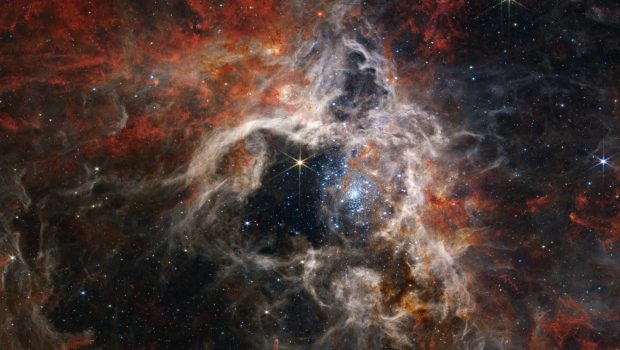Thanks to the space telescope, thousands of young stars that have remained invisible until now have become visible for the first time. James WebbInfrared eyes turned to a cosmic nursery astronomers call the Tarantula Nebula.
The nebula, also known as 30 Doradus, is a giant cloud of dust and hydrogen located in the Large Magellanic Cloud, a small galaxy about 160,000 light-years from Earth.
No other galaxy in the Milky Way’s neighborhood produces new stars at such a rate. Tarantula actually contains “the hottest and most massive stars known to astronomers,” he points out. His announcement Jet Propulsion Laboratory (JPL). NASA In California.
See Here Beautiful image in full resolution.
Also Read: How the James Webb Telescope will detect the first stars in the universe
New stars form when large masses of hydrogen collapse under their own weight and form a dense sphere. The increase in density, pressure, and temperature at the center of the sphere causes thermonuclear reactions that make the new star glow.
In Webb’s infrared image, the nebula looks like burrows dug by some spiders to catch their prey. Gas and dust are like a web covering the entrance.
In the center of the image is a cluster of light, blue, hot stars whose radiation has blown away the veil of hydrogen and dust, forming a cavity in the nebula.
Only dense clouds resist and form columns of gas, within which “proto-stars” that have not yet begun to shine are hidden.
The image of the nebula changes dramatically when the camera observes longer wavelengths of light in the mid-infrared. The nebula’s stars and dust fade, revealing proto-stars hidden within.

Image taken in mid-infrared focusing on the center of the nebula (NASA, ESA, CSA, STScI, Webb ERO Production Team)
One of the reasons the Tarantula Nebula attracts the interest of astronomers is that it allows them to observe astronomical processes in detail.
Today, our own Milky Way does not contain a dense mass of hydrogen and produces very few new stars each year. In contrast, the tarantula refers to the early stages of the universe’s evolution, when the abundance of free hydrogen was greater than today and the astral rate was at its maximum.
The process of new star formation still hides many mysteries because it is so far difficult to discern what happens inside such nebulae.
Thanks to infrared vision that penetrates the cosmic veils, Webb hopes to provide new clues about cosmic maternity hospitals and the developmental stages of stellar embryos.

Prone to fits of apathy. Unable to type with boxing gloves on. Internet advocate. Avid travel enthusiast. Entrepreneur. Music expert.



